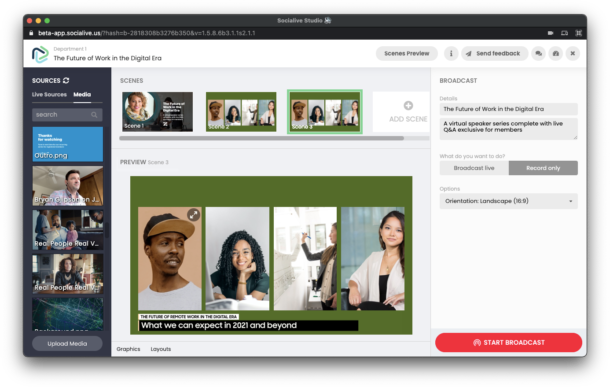As business leaders prepare for a hybrid future of in-person and remote collaboration, they join the quest to discover new ways to break barriers and maximize enterprise engagement in a post-pandemic world.
While no one wants to jump onto another Zoom call to stare at a grid of faces, when a virtual experience is executed well, it can strengthen employee and customer relationships.
To shake things up, Socialive’s latest rollout of product updates — such as more layouts, a simplified portal, and the ability to live stream meetings — were designed to empower organizations to unlock the power of video.
Another recently released (and commonly overlooked) feature is the ability to showcase an active speaker, video or slide in fullscreen without losing audio from others. The concept of fullscreen display is not necessarily new, but has a tremendous impact on the viewer’s experience during live panel discussions.
Below, we share five benefits of this new capability, and provide use case examples of how teams can effectively put it into action.
1. IT DELIVERS A HIGH QUALITY VIEWING EXPERIENCE
Let’s face it: HD full-screen video communication is the next best thing to in-person interaction.
With the option to maximize any video source within a layout, producers can easily bring a keynote speaker to life, similar to a CNN-style broadcast. In other words, the video of the speaker will occupy the entire broadcast, and is the only source visible to your audience.
Not only can you choose to zoom into panelists, but also a slide, infographic, video, or a screen share. When full-screen content is displayed, presenters no longer need to worry about viewer’s squinting at a tangled screen of text, colors, and branded graphics.
2. IT SUPPORTS A VARIETY OF CONTENT APPROACHES
Now you can maximize any guest or video source within a layout to display it full-screen in Socialive. Your audience will still hear the audio from the other sources in the layout, but only the maximized source will be visible. This is ideal for panel discussions, interviews, and webcasts.
The ability to maximize a guest or video source without losing audio from other speakers opens up several possibilities for content creators looking to grow engagement across the enterprise.
Here are some use case examples that leverage this capability:
-
Panel Discussions, Interviews, & Webcasts: During a live discussion, producers can zoom into a specific speaker as he or she answers a question — while maintaining the audio from the others. This keeps the conversation moving and encourages dialogue between panelists.
-
Product Tutorials & Demos: In real time, you walk through how-to’s or share tips and tricks with your audience through screen share.
-
Meetings & Webinars: Draw attention to relevant information such as educational material or research by zooming into a presentation slide or graphic in real time.
-
B-roll Footage & Sponsored Video Content: Easily showcase supplemental or alternative video footage while an interviewee speaks around it
3. GROW AUDIENCE ENGAGEMENT WITH DYNAMIC BROADCASTS
In a remote working environment with distractions such as email notifications and Slack alerts, how do you capture and hold the attention of your employees and customers?
As a presenter, it is critical to deliver your message in the simplest, most effective way to prevent viewers from tuning out. That’s why we made it even easier for producers to maintain full control of the show.
Ahead of your broadcast, we recommend planning the run of show and being mindful of what content will be visible to your audience. Identify moments when you want to zoom in on certain speakers, infographics, B-roll, or even interactive polls. We know your audience’s time is precious, so create a unique experience that is worth the time and investment.
Pro-tip: While preparing, take advantage of Scenes to eliminate setting up each scene on the fly.
4. SPOTLIGHT AN ACTIVE SPEAKER TO HUMANIZE YOUR BRAND
Showcase the active speaker in an interview or panel discussion while maintaining the audio of other guests in the scenes.
Without a human element, it is difficult for employees, prospects and customers to relate or feel connected to a company. After all, people want to hear from a person, not a company or grid of faces.
To help the world identify and connect with your business, it is critical to showcase a human side across every effort across departments. For example, for recruitment or employer branding purposes, showcase the diverse faces behind your brand by hosting an employee-only roundtable around a topic of interest.
Get up close and personal at an employee event by zooming into an individual speaker. This not only shifts the audience’s attention to what that speaker is stating, but also prevents them from potential distractions such as looking at the other speakers, or squinting to see who is speaking in a split-screen layout.
5. HIGHLIGHT KEY MOMENTS IN REAL TIME
Whether it’s an insightful conversation during a debate or an unexpected emotional moment at a long-awaited interview, the producer maintains full control of what is displayed in fullscreen to your audience in real time.
At their discretion, the producer can easily capture unplanned or compelling moments by deciding what content to display fullscreen. In just one click, you can maximize a scene within a layout on the fly or switch to display a video, chart, or screen share.
Stay tuned over the next couple of months as we introduce a few other exciting enhancements including in-app nameplates, lower-thirds, speaker notes, and Guest Directors.
To learn more about how to maximize a guest or video source, visit our Support Center.


